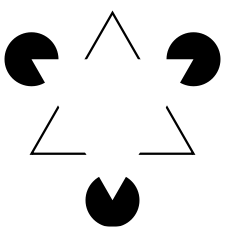Illusory contours

Illusory contours or subjective contours are visual illusions that evoke the perception of an edge without a luminance or color change across that edge. Illusory brightness and depth ordering frequently accompany illusory contours. Friedrich Schumann is often credited with the discovery of illusory contours around the beginning of the twentieth century,[1] however illusory contours are present in art dating to the Middle Ages. Gaetano Kanizsa’s 1976 Scientific American paper marks the resurgence of interest in illusory contours for vision scientists.
Common types of illusory contours
Kanizsa Figures (a.k.a. Pac-Man Configurations): Perhaps the most famous example of an illusory contour is the Pac-Man configuration popularized by Gaetano Kanizsa.[2] Kanizsa figurers trigger the percept of an illusory contour by aligning Pac-Man-shaped inducers in the visual field such that the edges form a shape. Though not explicitly part of the image, Kanizsa figures evoke the percept of a shape, defined by a sharp illusory contour. Typically, the shape seems brighter than the background though luminance is in reality homogeneous. Additionally, the illusory shape seem to be closer to the viewer than the inducers. Kanizsa figures involve modal completion of the illusory shape and amodal completion of the inducers.

Closely related to Kanizsa figures is the Ehrenstein illusion. Instead of employing Pac-Man inducers, the Ehrenstein illusion triggers an illusory contour percept via radial line segments. Ehrenstein’s discovery was originally contextualized as a modification of the Hermann grid.[3]
Abutting Line Gratings: Illusory contours are also created at the boundary between two misaligned gratings.[4] In these so-called abutting line gratings, the illusory contour is perpendicular to the inducing elements.
Explanation
It is thought that early visual cortical regions such as V1 V2 are responsible for forming illusory contours.[5][6]
Illusory contours in art and graphic design
Olympic logos from ’72, ’88, ’84, and ’94 all feature illusory contours as does Ellsworth Kelly's 1950s series
Related visual phenomena

Visual illusions are useful stimuli for studying the neural basis of perception because they hijack the visual system’s innate mechanisms for interpreting the visual world under normal conditions. For example, objects in the natural world are often only partially visible. Illusory contours provide clues for how the visual system constructs surfaces when portions of the surface’s edge are not visible.
The encoding of surfaces is thought to be an indispensable part of visual perception, forming a critical intermediate stage of visual processing between the initial analysis of visual features and the ability to recognize complex stimuli like faces and scenes.[7]
References
- ↑ Schumann, F (1900), "Beiträge zur Analyse der Gesichtswahrnehmungen. Erste Abhandlung. Einige Beobachtungen über die Zusammenfassung von Gesichtseindrücken zu Einheiten.", Zeitschrift für Psychologie und Physiologie der Sinnesorgane 23: 1–32
- ↑ Kanizsa, G (1955), "Margini quasi-percettivi in campi con stimolazione omogenea.", Rivista di Psicologia 49 (1): 7–30
- ↑ Ehrenstein, W (1941), "Über Abwandlungen der L. Hermannschen Helligkeitserscheinung (Modifications of the Brightness Phenomenon of L. Hermann).", Zeitschrift für Psychologie 150: 83–91
- ↑ Soriano, M; Spillmann, L; Bach, M (1996), "The abutting grating illusion.", Vision Res. 35 (1): 109–116, PMID 8746248
- ↑ von der Heydt, R; Peterhans, E; Baumgartner, G (1984), "Illusory contours and cortical neuron responses", Science 244 (4654): 1260–1262, doi:10.1126/science.6539501, PMID 6539501
- ↑ Barghout, Lauren (2014). Vision. Global Conceptual Context Changes Local Contrast Processing (Ph.D. Dissertation 2003). Updated to include Computer Vision Techniques. Scholars' Press. ISBN 978-3-639-70962-9.
- ↑ Nakayama, K; He, Z; Shimojo, S (1995). "Visual surface representation: a critical link between lower-level and higher level vision". An Invitation to Cognitive Science: Visual cognition 2. pp. 1–70.
External links
- Coren, S (1972), "Subjective contour and apparent depth", Psychological Review 79 (4): 359–367, doi:10.1037/h0032940, PMID 5038153
- Illusory contours figures Many unpublished drawings (fr)